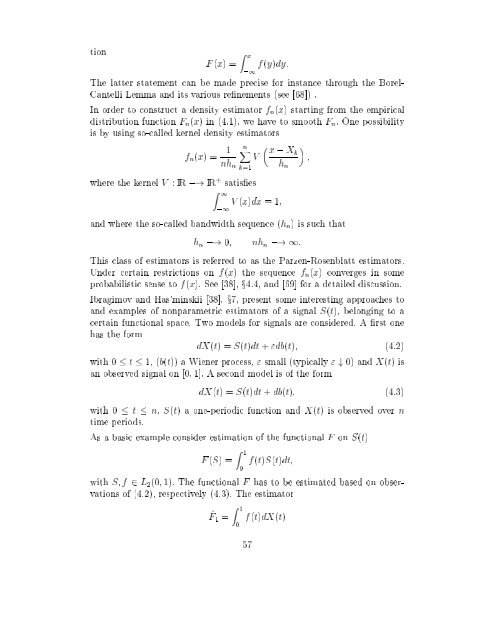Estimation in Financial Models - RiskLab
Estimation in Financial Models - RiskLab
Estimation in Financial Models - RiskLab
You also want an ePaper? Increase the reach of your titles
YUMPU automatically turns print PDFs into web optimized ePapers that Google loves.
tion<br />
F (x) =<br />
Z x<br />
,1<br />
f(y)dy:<br />
The latter statement can be made precise for <strong>in</strong>stance through the Borel-<br />
Cantelli Lemma and its various renements (see [68]) .<br />
In order to construct a density estimator f n (x) start<strong>in</strong>g from the empirical<br />
distribution function F n (x) <strong>in</strong> (4.1), we have to smooth F n . One possibility<br />
is by us<strong>in</strong>g so-called kernel density estimators<br />
nX x , Xk<br />
f n (x) = 1<br />
nh n<br />
k=1<br />
where the kernel V :IR ,! IR + satises<br />
Z 1<br />
,1<br />
V<br />
V (x)dx =1;<br />
and where the so-called bandwidth sequence (h n )issuch that<br />
h n<br />
h n ,! 0; nh n ,!1:<br />
This class of estimators is referred to as the Parzen-Rosenblatt estimators.<br />
Under certa<strong>in</strong> restrictions on f(x) the sequence f n (x) converges <strong>in</strong> some<br />
probabilistic sense to f(x). See [38], x4.4, and [69] for a detailed discussion.<br />
Ibragimov and Has'm<strong>in</strong>skii [38], x7, present some <strong>in</strong>terest<strong>in</strong>g approaches to<br />
and examples of nonparametric estimators of a signal S(t), belong<strong>in</strong>g to a<br />
certa<strong>in</strong> functional space. Two models for signals are considered. A rst one<br />
has the form<br />
dX(t) =S(t)dt + "db(t); (4.2)<br />
with 0 t 1, (b(t)) a Wiener process, " small (typically " # 0) and X(t) is<br />
an observed signal on [0; 1]. A second model is of the form<br />
<br />
;<br />
dX(t) =S(t)dt + db(t); (4.3)<br />
with 0 t n, S(t) a one-periodic function and X(t) is observed over n<br />
time periods.<br />
As a basic example consider estimation of the functional F on S(t)<br />
F (S) =<br />
Z 1<br />
0<br />
f(t)S(t)dt;<br />
with S; f 2 L 2 (0; 1). The functional F has to be estimated based on observations<br />
of (4.2), respectively (4.3). The estimator<br />
^F 1 =<br />
Z 1<br />
0<br />
f(t)dX(t)<br />
57
















